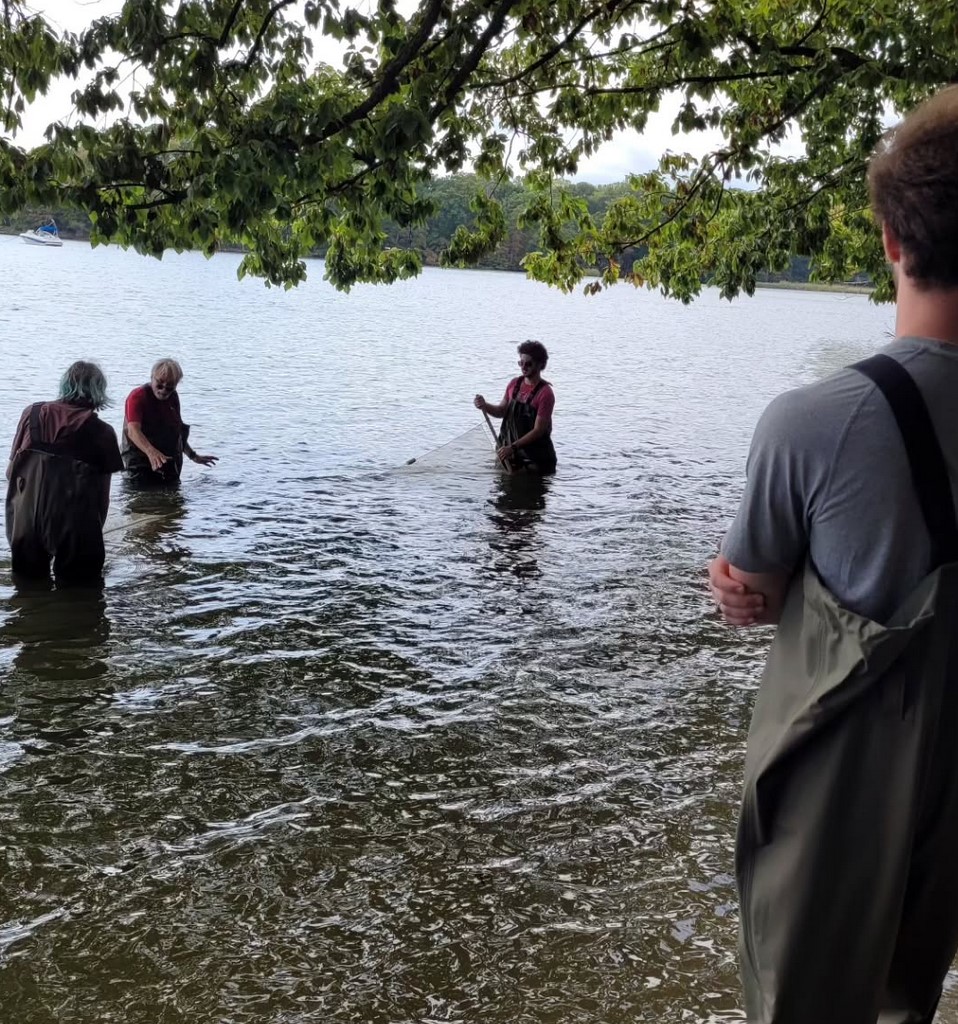Event name: Trip to National Air and Space Museum for Planet Science Exhibits
Event time and place: Edgewater, MD. Saturday, Sept 21, 8:00 AM

Me operating the seine net.
The day started out with a long drive to the Eastern Shore. (It honestly probably wasn’t all that long, but having to get up at 7 on a Saturday morning sure made it feel that way.) After shaking off the grogginess and getting out of the van, we left our things in the nature center and set off on the first event of the day, a guided hike through SERC’s trails that took us through a small portion of the facility’s forests and marshlands.
The Smithsonian Environmental Research Center is an organization devoted to acting as a laboratory for the ecological sciences, providing critical opportunities for the study of the natural world and humankind’s impact on the most sensitive areas. The Chesapeake wetlands are just as critical to the local ecosystem as they are threatened by climate change, water pollution, invasive species and more. The people running the tour were quite vocal in their dislike for Phragmites grass, a plant that originated in Europe sometime around the 1800s but has recently vastly increased its rate of expansion, something that is monitored in several sites by SERC researchers. On the SERC webpage, it describes the research into Phragmites in greater detail, outlining how the recent explosive growth pattern is driven by an increase in genetic diversity in the species. Research like this impacts not only the Chesapeake, but coastal regions across America, providing important insights on how to prevent Phragmites invasions and support native species. This marshy area was also home to a small dock with a sunken platform in the center, low enough that the wood was still wet from the last high tide. We learned on this dock that the local otter population frequented it, as evidenced by droppings and then trail camera footage. Otters, being a predatory species, can offer insights into the health of the Chesapeake Bay watershed through the bones of various species and parasites present in their droppings. The marsh habitats are faced with more direct threats as well. While we were there, a jet ski ripped by at speeds high enough to send waves crashing into the shore. Although just one fast boat can’t cause too much damage, repeated wakes can contribute to erosion and further stress upon the sensitive wetland environment. Moving further down the trail and onto Hog Island, we got a tour of the small forested island and the previous research that had gone on there.
Soon, we would head back to the nature center for lunch. The nature center had several fish tanks and a small reading area with environment-related books for younger children. As part of its mission to educate the public, SERC runs field trip programs not entirely unlike the activities we participated in, but suited towards K-12 students. These are tailored to educate and foster interest in environmental science, and range in which grades they’re aimed at. For more motivated teens, they offer a summer program that goes beyond what one can accomplish in just a day, and gets them further involved in the research. In my opinion, this is an excellent strategy for public outreach. As a research organization, directly advocating for action isn't within their scope as much as inspiring the next generation of scientists, engineers, environmentalists, and more. However, I think they could do a better job at advertising their existence, perhaps a small display somewhere in the National Museum of Natural History.
After lunch, we moved to focus on the next habitat of the day. Turning our attention from the water’s edge and the wetlands to the shallows just beyond, we participated in a seining activity that had us use large nets to scoop up aquatic wildlife from various zones on a shoreline, then sort and classify them. Even this small beach had a range of smaller sub-habitats within it, the prevalence of different kinds of marine organisms changing depending on whether we were shallower, deeper, in clear water or by a sunken tree, etc. These shoreline habitats are affected by human activity just as much as the wetlands. Fertilizer runoff and a high level of sunlight makes these shallows the perfect environment for explosive growth of algae and submerged vegetation, which can disrupt ecosystems and choke out the wildlife present via eutrophication. These same concerns were present for the other slightly deeper marine ecosystem we investigated off the edge of the dock, where we participated in a similar classification activity using small cages that sampled some of the wildlife living on the riverbed below the dock. During this activity, we pulled up an American Eel, a rare find that inspired a talk about their unusual migration cycles. The sea life living around the Bay at various times of the year is another SERC research subject. Although it may seem more local, the migrations of marine organisms can span thousands of miles, and have profound effects and insights relating to the health of fisheries. Accurate scientific data is required in order to inform regulators of fisheries as to what the quotas should be to prevent overfishing.
In the end, the day at SERC was well spent, and I learned a lot about what goes into researching the critical ecosystems of the Chesapeake Bay. Overall, it was very refreshing to see that for all the doom and gloom surrounding the environment, there are people passionate about its preservation, and not only that, but the pursuit of knowledge, of concrete progress rather than vague calls to action. Were I still interested in biology as a career, I would absolutely look into an internship at SERC, and would encourage others to do the same.


